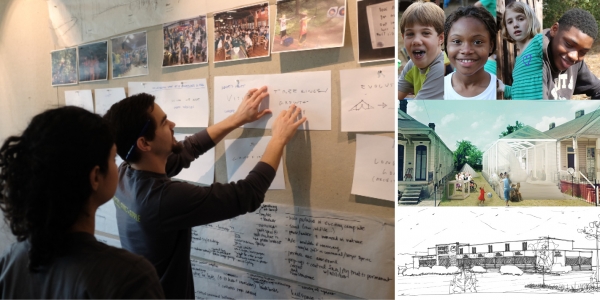Building Health in our Communties | 2016 EDR MLK Day of Service

We are excited to announce the second annual Martin Luther King Jr. Day of Service on January 18, 2016. As part of the firm’s commitment to building community, Eskew+Dumez+Ripple has implemented a skills-based service program to benefit community organizations in the New Orleans region. Each year, the entire staff is available for one work day to provide their talents for community focused initiatives. Through this design marathon, stakeholders participate in a collaborative design process adapted to their particular project.
Last year, working with the Arts Council of New Orleans for the Day of Service, Eskew+Dumez+Ripple produced a series of maps to analyze the conditions of a particular neighborhood. Through the analysis, the team pinpointed the most viable sites for an adaptable pavilion that could act as a public space and easily house any supplementary need that arose in the community. Whether a short term fresh foods market or an entertainment pavilion, the envisioned wooden cubes in the space could be reconfigured to provide seating, storage or a temporary wall system.
WHY THE FOCUS ON HEALTH?
Each year Eskew+Dumez+Ripple hires a research fellow to focus attention on an area of interest in the built environment and uses the knowledge gained to directly influence the firm’s design approach. This year, in light of the opening of the Veterans Affairs Medical Center and New Orleans East Hospital, health is the focus. Recently, health initiatives have garnered extra attention across the country with the establishment of a the Affordable Care Act. More and more companies are creating incentive programs in an effort to reduce healthcare costs for their employees. Health is a top priority for all, but what role does the built environment play?In 2013 a team of researchers from the University of Chester in England found that people who stood for 3 hours a day, five days per week burned around 750 calories more than those who sat throughout the day, adding up to 30,000 calories or 8 lbs of fat. Imagine how multiplying standing hours over the course of many people’s lifetimes could change our collective health. Another study from the University of Utah in Salt Lake City released this year studied mortality compared to the intensity of activity that a person undertook over the years. Examining observational data from the National Health and Nutrition Examination Survey (NHANES), they found that simply walking for two minutes each hour lowered the risk of premature death by 33% compared with those remaining sedentary throughout the day. It’s clear that small changes in everyday habits can significantly influence our overall health.For architects, the question becomes: can we incentivize small positive changes through the design of our environment? Collections of statistics from the Active Living Research organization reveal critical behavioral patterns that could inspire a vision for improvement of your neighborhood and increased quality of life.
A FEW FACTS TO CONSIDER
- People who live in walkable neighborhoods are two times as likely to get sufficient physical activity compared to those who do not. People who live in neighborhoods with sidewalks along most streets are 47% more likely to be active at least 30 minutes a day.
- Students who walk to school every day enjoy, on average, 24 more minutes of physical activity per day.
- Public transit users take 30% more steps per day than people who rely on cars.
- Teens who live in blighted neighborhoods are 50% less likely to have access to recreational facilities within their community yet those in neighborhoods with such access are 26% more likely to be active five times per week.
- The number of children who are physically active outside is 84% higher when schoolyards are kept open for public play.
- People who live near trails are 50% more likely to meet physical activity guidelines. A Nebraska study showed that every $1 spent on trails resulted in $3 of savings in direct medical costs.
If we consider all shared spaces—from the empty lot, the park, the streets and sidewalks—as public spaces, what improvements might we envision to transform those spaces into lively places that strengthen the vitality of our neighborhoods? What would make a student’s walking path from home to school safer and more practical? What about for a public transit user?
Click here to download this year’s Day of Service request for proposals. If you have any questions please contact Marina Michael (mmichael@eskewdumezripple.com).
